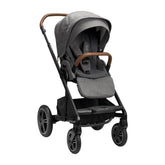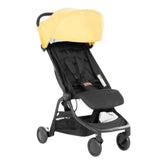Birth Control After Baby: The Best Options for New Moms

Updated: 18 Dec 2024
Without birth control, it’s possible to get pregnant again quickly after having a baby. Though contraception may not be top-of-mind when you’re a new mom, it’s important to have a designated plan in place. Reliable birth control gives you more control over your family planning decisions and helps you avoid an unintentional pregnancy.
Postpartum moms may be fertile again before they even realize it. With the return of ovulation, a woman can become pregnant again. Mothers who aren’t breastfeeding may ovulate within weeks of giving birth. Breastfeeding moms may experience a delay in ovulation, but the cycle normally resumes in around six months. And since ovulation typically happens a couple of weeks before a period starts, it is possible to become pregnant even before having a regular period.
When Is the Best Time To Do Family Planning After Delivery?
The American College of Obstetrics and Gynecologists (ACOG) recommends that parents have an established and proactive birth control plan in place as soon as possible after their baby is born. There are several methods available, some before you even leave the hospital.
What Are the Best Birth Control Options After Having a Baby?
As you weigh your options, ACOG recommends you consider the following:
- Efficacy. The birth control you used before may not work well after having a baby. The cervical cap and sponge, for example, aren’t as effective in women who’ve experienced childbirth.
- Your timetable. Some methods offer immediate protection, while other methods require a delay in starting.
- Nursing. All forms of birth control are safe for nursing mothers and babies. A few methods, however, may be less than ideal for the first few weeks postpartum as they may impact your milk supply.
With that in mind, let’s take a look at a few birth control options after having a baby.
Long-Acting Reversible Contraceptive (LARC) Devices
Long-acting reversible contraceptive (LARC) devices are a category of birth control that includes intrauterine devices (IUDs) and implants placed under the skin, like Nexplanon.
- Implants: For an implant, your doctor will make a tiny incision in your inner arm and place a small flexible rod (about the size of a matchstick). This rod releases the hormone progestin into the body which controls ovulation. It is approved for up to 3 years of use.
- IUDs: For an IUD, your physician places a T-shaped apparatus made of plastic (which contains hormones) or copper (hormone-free) into the uterus. IUDs can be inserted immediately after vaginal or cesarean birth or at your first postpartum health care visit. These devices work by preventing the sperm and egg from joining. Plastic IUDs are approved for up to 3 to 6 years of use. Copper IUDs are approved for up to 10 years of use.
Birth Control After Pregnancy: Side Effects of LARC Devices
Neither IUDs nor implants interfere with sex or daily activities. Once inserted, a woman does not have to do anything else to prevent pregnancy. There are possible side effects to keep in mind, including irregular bleeding, headaches, and mood changes. With IUDs, there is also a slight chance of infection or injury. If you feel a LARC device may be a good option for you, talk with your doctor before you go into labor so they can ensure the hospital has the device you want available.

Combination Hormone Methods: Pills, Ring, and Patch
Other birth control methods offer a combination of the hormones estrogen and progestin to prevent ovulation so that conception never occurs. Depending on the brand, you may use these methods continuously or take a week off. Generally speaking, you have three options:
- Birth control pills. These are taken daily
- Vaginal ring. These are inserted every three weeks
- Transdermal patch. The patch is applied once every 7 days for 21 days.
None of these methods interfere with sex. They are more than 90 percent effective when used correctly, but they do require vigilant adherence to the usage instructions. They may also pose risks for some women. Combination hormone methods are not generally recommended for women who smoke, experience migraines, have a history or risk of breast cancer, or experience blood clots or high blood pressure.
Birth Control After Pregnancy While Breastfeeding
It’s worth noting that combination hormone methods of contraception may affect your milk supply if you’re nursing. Therefore, ACOG recommends breastfeeding mothers avoid these methods for at least the first four to six weeks after delivery until breastfeeding is well-established.

Progestin-Only Methods: Injections and Pills
The birth control shot contains medroxyprogesterone acetate (DMPA), a type of progestin that prevents ovulation. If you decide to use the birth control shot, your doctor will give you the injection once every 3 months. It’s 94 percent effective and can be administered right after cesarean or vaginal delivery.
Progestin-only birth control pills (sometimes called the “mini-pill”) work by preventing fertilization of the egg by the sperm. These pills can be started immediately after childbirth. They are much less flexible in terms of timing than combination pills and must be taken at precisely the same time each day. If you miss a pill by more than three hours, you will have to use an alternative contraception method for the following 48 hours.
Natural Birth Control After Childbirth
Barrier Methods
Barrier methods of contraception work by blocking a man’s sperm from reaching and fertilizing a woman’s egg. These include the sponge, cervical cap, diaphragm, female and male condoms, and spermicide.
Spermicide and condoms can be used at any point postpartum. The sponge, diaphragm, and cervical cap can be used when the cervix and uterus have had time to shrink back to their normal size, approximately six weeks after giving birth. If you used a diaphragm before having a baby, you may need to be refitted after pregnancy.
Of these methods, condoms are the only form of birth control that also offers protection from sexually transmitted diseases. In addition, barrier methods have no effect on a woman's hormonal cycle. However, there are a few disadvantages. Barrier methods are less effective against unintended pregnancies than previously mentioned methods. They may also cause issues for those who have sensitivities to spermicide or latex.
Lactational Amenorrhea Method (LAM)
Lactational amenorrhea method (LAM) is a contraception method based on the manner in which the female body temporarily halts ovulation while breastfeeding. To be effective, the woman must engage in frequent, exclusive nursing – absolutely no supplementing with formula. There must also be less than four hours between every feeding, day or night. Periods must not have started, and the infant must be younger than six months old. This method is free, all-natural, and poses no health risks. Some sources argue that pumping breast milk decreases the effectiveness of LAM, but the research is unclear.

Permanent Birth Control After Childbirth: Sterilization
More permanent forms of birth control may be an option for women who have decided not to have more children.
Tubal Ligation
In women, sterilization is performed by a procedure called tubal ligation. This involves blocking or removing the fallopian tubes and is more than 99 percent effective. This procedure can be performed while you’re still in the hospital if you had a caesarian delivery or performed later laparoscopically. Not all hospitals offer sterilization, however, so check ahead of time if you are interested in this option.
Vasectomy
In men, sterilization involves a minor procedure called a vasectomy, which involves a tiny cut to the tube sperm travels through during orgasm. This cut blocks sperm from leaving the testicles. Though semen will still be released during orgasm, it will not contain any sperm and thus cannot fertilize an egg. It takes several weeks for all the sperm to be completely cleared from semen. About three months after the procedure, the vasectomy will be almost 100 percent effective at preventing pregnancy.
The Takeaway on Birth Control Options for New Moms
Sifting through all available birth control options can feel a bit overwhelming, especially with a new baby to care for. Talk to your healthcare provider about your questions and concerns and consider their advice. No matter what you ultimately choose, it’s not a decision you should postpone. There’s a method for everyone, and you’ll have more peace knowing you’ve got a strategy in place.









